Dear friends,
I came back from a three-week research trip from Iran. This time I had the opportunity to measure and take pictures of firearms from the Early Safavid period (matchlocks) and then flintlocks and percussion cap guns. Marvelous pieces. The majority over 90 percent were with barrels of breath-taking pattern welded steel. Really nice. The whole inventory (including swords, etc) of the Military Museum of Tehran belonged to the collections of Qajar Kings (who inherited many items from the Safavid period, among them many royal swords and guns. The results of this research will be published in one of my upcoming books on Persian firearms. As they are all with provenance they can be used for comparative purposes.
I also have some good news on European arms collections in museums which I will post here soon.
Meanhilw, does any of you have experience in European firearms with pattern-welded steel? If yes I appreciate your input and pictures.
Kind regards
Manouchehr
P.S: Sorry I have been very busy lately with ym second books and articles hence my long absence. I will post some nice pictures soon.
| Manouchehr M. wrote: |
| Dear friends,
I came back from a three-week research trip from Iran. This time I had the opportunity to measure and take pictures of firearms from the Early Safavid period (matchlocks) and then flintlocks and percussion cap guns. Marvelous pieces. The majority over 90 percent were with barrels of breath-taking pattern welded steel. Really nice. The whole inventory (including swords, etc) of the Military Museum of Tehran belonged to the collections of Qajar Kings (who inherited many items from the Safavid period, among them many royal swords and guns. The results of this research will be published in one of my upcoming books on Persian firearms. As they are all with provenance they can be used for comparative purposes. I also have some good news on European arms collections in museums which I will post here soon. Meanhilw, does any of you have experience in European firearms with pattern-welded steel? If yes I appreciate your input and pictures. Kind regards Manouchehr P.S: Sorry I have been very busy lately with ym second books and articles hence my long absence. I will post some nice pictures soon. |
Manoucher, I believe I saw a Swedish fowler with a patterned barrel once. I think it was dated 1814. I couldn't tell you anymore than that though.
| Ian Hutchison wrote: | ||
Manoucher, I believe I saw a Swedish fowler with a patterned barrel once. I think it was dated 1814. I couldn't tell you anymore than that though. |
Thanks Ian for the information. I really appreciate it. Do you know in which museum it was located?
Kind regards
Manouchehr
| Manouchehr M. wrote: | ||||
Thanks Ian for the information. I really appreciate it. Do you know in which museum it was located? Kind regards Manouchehr |
It was privately owned. It was for sale online some time ago (last year).
I also found something at: http://www.peterdyson.co.uk/acatalog/index.html#infolines
He is selling:
"Original Damascus barrels suitable for building pistols, shotguns or rifles. These original Damascus tubes were made in Belgium around 1890 and have been in storage since then. They were discovered and shipped to England in Spring 2003. The fine Belgian barrel makers i.e. Oscar & Lucien Delcour of J. Delcour=Dupont and E. Heuse- Lemoine of Nessonvaux, near Liege made these tubes and many are stamped with their makers mark."
I have seen some jezails with patterned Belgian barrels.
Last edited by Ian Hutchison on Mon 17 Mar, 2008 12:07 am; edited 1 time in total
Hello Manoucher,
I would think that quite a lot of people will have older European guns with stub-iron twist, or "damascus" pattern barrels.
Does the age of the firearm matter?
I have some pictures of one or two of my own guns I could send you. They are from the 19th century.
I could post pictures here, or send them to you.
Best wishes,
Richard.
I would think that quite a lot of people will have older European guns with stub-iron twist, or "damascus" pattern barrels.
Does the age of the firearm matter?
I have some pictures of one or two of my own guns I could send you. They are from the 19th century.
I could post pictures here, or send them to you.
Best wishes,
Richard.
Hi Ian,
Thank you very much for your kind input. I really appreciate it.
Kind regards
Manouchehr
Thank you very much for your kind input. I really appreciate it.
Kind regards
Manouchehr
| Richard Hare wrote: |
| Hello Manoucher,
I would think that quite a lot of people will have older European guns with stub-iron twist, or "damascus" pattern barrels. Does the age of the firearm matter? I have some pictures of one or two of my own guns I could send you. They are from the 19th century. I could post pictures here, or send them to you. Best wishes, Richard. |
Hello Richard,
Thank you very much for your kind offer. Would you please post them here so everyone can see and enjoy them and we can open a discussion on them? No age does not matter. Thank you very much again.
Kind regards
Manouchehr
Good morning Manouchehr,
I will ask my daughter to post some pictures today. (I have not figured out how to do it myself, yet!)
One picture of a pair of stub-twist barrels from the 1840's,
and one of a pair of damascus barrels with a large figure, from the 1860's.
I have not at present photos of other examples, but could try and take some if of interest.
It would be Very interesting to see your work on this subject, when it is finished!!!
Best wishes,
Richard.
I will ask my daughter to post some pictures today. (I have not figured out how to do it myself, yet!)
One picture of a pair of stub-twist barrels from the 1840's,
and one of a pair of damascus barrels with a large figure, from the 1860's.
I have not at present photos of other examples, but could try and take some if of interest.
It would be Very interesting to see your work on this subject, when it is finished!!!
Best wishes,
Richard.
Here are a few pictures of the damascus barrels:
 Attachment: 80.08 KB
Attachment: 80.08 KB
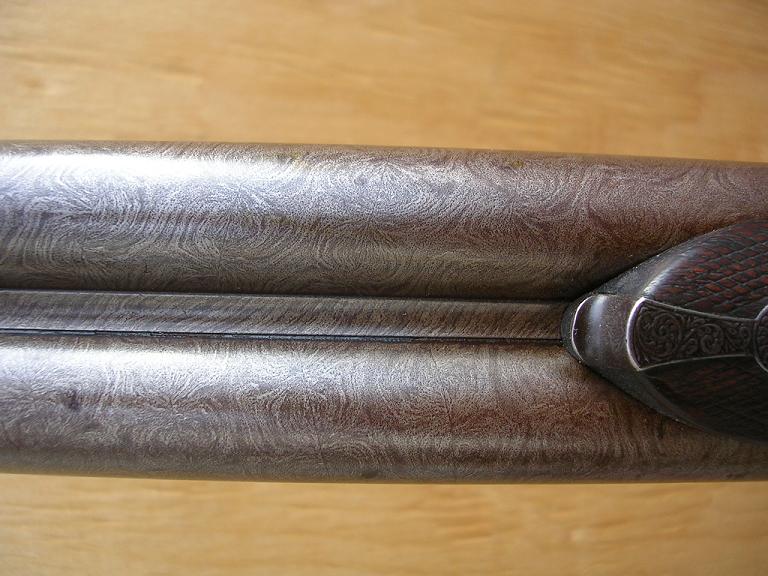
 Attachment: 74.7 KB
Attachment: 74.7 KB
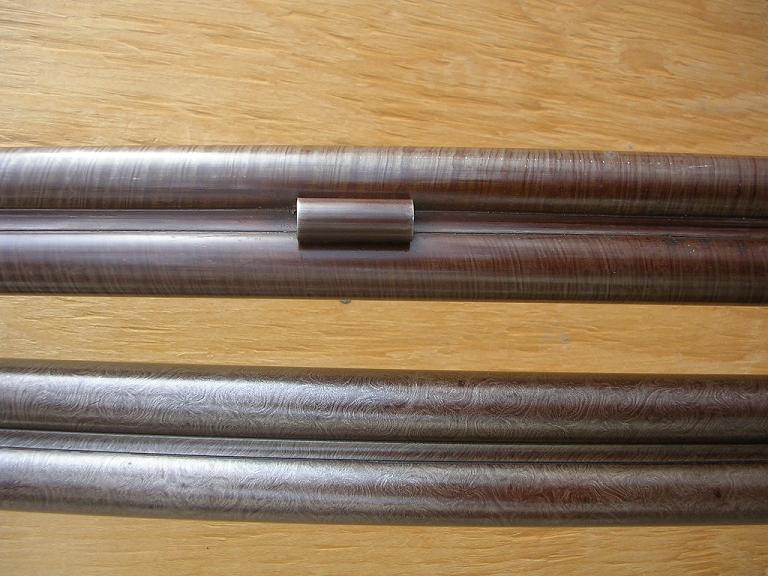
 Attachment: 58.75 KB
Attachment: 58.75 KB
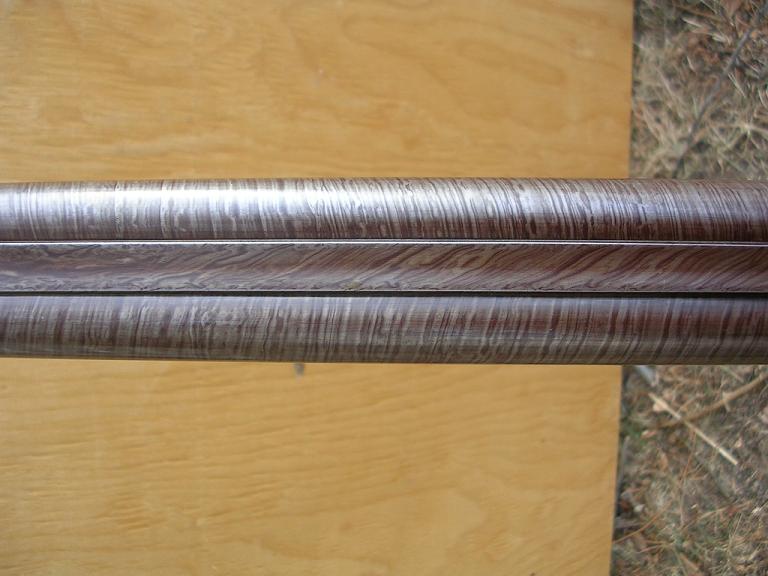
 Attachment: 72.56 KB
Attachment: 72.56 KB





Richard,
Thank you very much for your kind words. These are beautiful and fascinating examples. Do you have information on how this type of barrels were made in Europe? Really fascinating examples. Could you give us a close-up of the percussion system?
Thanks again.
Kind regards
Manouchehr
Thank you very much for your kind words. These are beautiful and fascinating examples. Do you have information on how this type of barrels were made in Europe? Really fascinating examples. Could you give us a close-up of the percussion system?
Thanks again.
Kind regards
Manouchehr
Manouchehr,
I am pleased you like the photos!
Though I am rather tied up trying to mend a tractor, I will try and take pictures as you request.
Re. construction of such barrels, probably a web-search of "Damascus barrels" would turn up the appropriate information, but here is a very brief description.
Most barrels of the 18th, and early 19th century, (In England, at least) were of a "Stub iron" construction.
This name comes from the fact that most were made from the stubs of old horseshoe nails, gathered from the roads by poor people as a form of income.
These nails were used, as they were nearly pure iron, and regarded as best for gun barrels.
The nails were placed inside an iron ring very tightly, and heated to forging temperature, then hammer welded into one solid piece.
Next, they were drawn out into a long ribbon, maybe 3/4 of an inch wide, (about 2cm)
This ribbon was tapered in thickness, but remained the same width.
Next, the ribbon was heated at one end, and a few twists were made around a hard steel mandrel.
the twisted ribbon portion was again heated, and was "Jumped" by striking one end on the anvil. this brought the edges of the twisted portion together, so that it could then be forge -welded. The small portion to be welded, was again brought up to welding heat, and the mandrel re-introduced before the weld could be made.
I gather that weding had to be accomplished within about ten seconds, before heat was lost.
This process, of winding the ribbon, "jumping" the ribbon, and welding an inch or so at a time, continued until the tube was completed.
Once complete, it was thoroughly hammered, and the a boring bit was used to clean out the inside, when nearly clean of imperfections, a fine borer would then be used.
This was a very smooth, sharp edged square cutter maybe 8 inches long, attached to a long rod. this was turned through the bore, with a wooden "slipper" paced against one of the flats.
The cutter was oiled and passed through the bore whilst being rotated.
when completely through, it was cleaned of the metal scrapings and retuned to the staring eng.
Paper was then added under the "slipper" and the cutter turned through the bore again.
this continued util the bore was completely shiny, even and smooth.
The outside was ground down, on large wet-stones, and finished with files and abrasive paper, before having the breech-plug fitted.
The only difference between the stub barrels and "damascus" was that with damascus barrels, long rods of iron and steel were drawn out, and then two, or three were twisted together, then in turn two or three of these twisted rods were twisted together, before being drawn out into the ribbon.
This produced the swirling patterns seen on the later guns. Damascus seems to have been introduced about 1826, (going by memory!)
I am sorry this is a very simplified version of how this process was accomplished!....... I do hope it is not too confusing!
WW Greener's book "The gun and its developement" probably has a much more complete description of how this was done.
Best wishes,
Richard.
I am pleased you like the photos!
Though I am rather tied up trying to mend a tractor, I will try and take pictures as you request.
Re. construction of such barrels, probably a web-search of "Damascus barrels" would turn up the appropriate information, but here is a very brief description.
Most barrels of the 18th, and early 19th century, (In England, at least) were of a "Stub iron" construction.
This name comes from the fact that most were made from the stubs of old horseshoe nails, gathered from the roads by poor people as a form of income.
These nails were used, as they were nearly pure iron, and regarded as best for gun barrels.
The nails were placed inside an iron ring very tightly, and heated to forging temperature, then hammer welded into one solid piece.
Next, they were drawn out into a long ribbon, maybe 3/4 of an inch wide, (about 2cm)
This ribbon was tapered in thickness, but remained the same width.
Next, the ribbon was heated at one end, and a few twists were made around a hard steel mandrel.
the twisted ribbon portion was again heated, and was "Jumped" by striking one end on the anvil. this brought the edges of the twisted portion together, so that it could then be forge -welded. The small portion to be welded, was again brought up to welding heat, and the mandrel re-introduced before the weld could be made.
I gather that weding had to be accomplished within about ten seconds, before heat was lost.
This process, of winding the ribbon, "jumping" the ribbon, and welding an inch or so at a time, continued until the tube was completed.
Once complete, it was thoroughly hammered, and the a boring bit was used to clean out the inside, when nearly clean of imperfections, a fine borer would then be used.
This was a very smooth, sharp edged square cutter maybe 8 inches long, attached to a long rod. this was turned through the bore, with a wooden "slipper" paced against one of the flats.
The cutter was oiled and passed through the bore whilst being rotated.
when completely through, it was cleaned of the metal scrapings and retuned to the staring eng.
Paper was then added under the "slipper" and the cutter turned through the bore again.
this continued util the bore was completely shiny, even and smooth.
The outside was ground down, on large wet-stones, and finished with files and abrasive paper, before having the breech-plug fitted.
The only difference between the stub barrels and "damascus" was that with damascus barrels, long rods of iron and steel were drawn out, and then two, or three were twisted together, then in turn two or three of these twisted rods were twisted together, before being drawn out into the ribbon.
This produced the swirling patterns seen on the later guns. Damascus seems to have been introduced about 1826, (going by memory!)
I am sorry this is a very simplified version of how this process was accomplished!....... I do hope it is not too confusing!
WW Greener's book "The gun and its developement" probably has a much more complete description of how this was done.
Best wishes,
Richard.
Here are some pictures of the percussion system:
 Attachment: 99.34 KB
Attachment: 99.34 KB
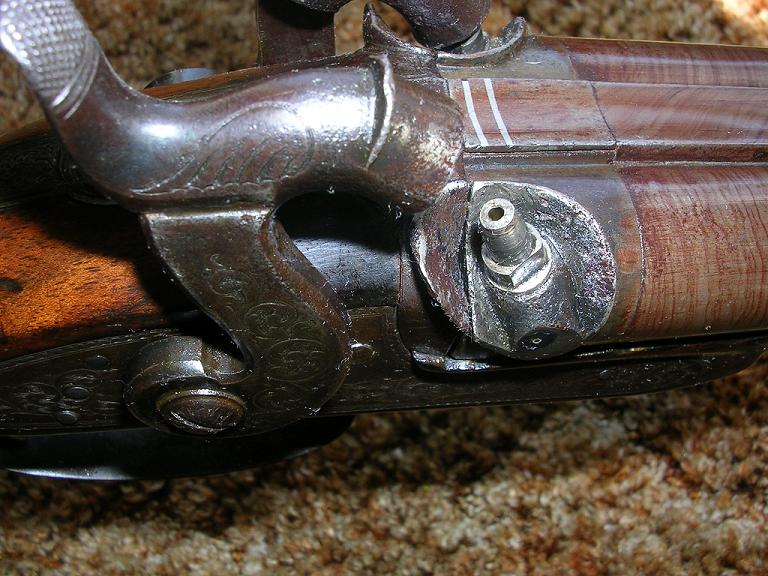
 Attachment: 96.81 KB
Attachment: 96.81 KB

 Attachment: 149.64 KB
Attachment: 149.64 KB
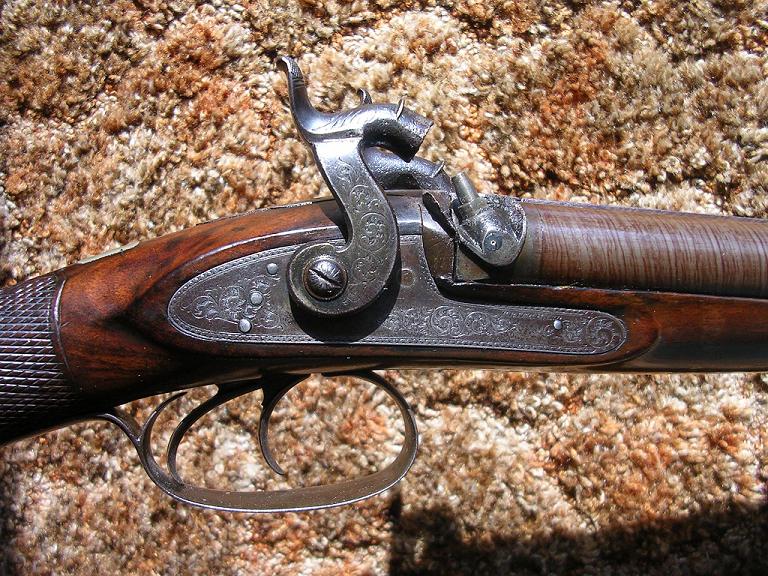



Richard,
Fascinating account. I really appreciate it and thank you very very much. The percussion caps look marvelous. Where were they made? Could you explain the function of priming and how it worked on these guns? Thank you very much.
KInd regards
Manouchehr
Fascinating account. I really appreciate it and thank you very very much. The percussion caps look marvelous. Where were they made? Could you explain the function of priming and how it worked on these guns? Thank you very much.
KInd regards
Manouchehr
Manouchehr,
The percussion system of ignition seems to have spread around the world rather quickly, once it had developed into the
standard copper cap.
(The use of a fulminate powder had been developed by a Scottish clergyman, named John Alexander Forsythe, in 1807, and his famous "Scent-bottle lock was the fist of many different inventions, before the copper cap became standard)
By the 1830's or 40's, most powers had adopted this system, though many sportsmen had adopted it by the late 1820's.
The example in the photogrphs was mad in England, in about 1840.
I am again asking Sarah to post some more pictures, showing how the priming works.
One picture will show the lock with the hammer down, in the "rest" position.
Another pic. will show the lock at half-cock. This is the "safe" position. When half-cocked, a small copper cap is placed on the nipple, (after the gun is loaded from the muzzle with powder, wadding and projectile)
Another picture will show the lock at full- cock. In this position, the hammer is pulled all the way back, and is ready to fire.
One final picture will show the hammer down, on the cap, in the 'fired' position.
Also, there will hopefully be a picture of the pattern on a set of flintlock barrels made in 1811 or 1812.
I can not say for sure what order the pictures will appear in. but by reading this and looking at the pictures, it should be fairly easy to work out.
Best wishes,
Richard.
The percussion system of ignition seems to have spread around the world rather quickly, once it had developed into the
standard copper cap.
(The use of a fulminate powder had been developed by a Scottish clergyman, named John Alexander Forsythe, in 1807, and his famous "Scent-bottle lock was the fist of many different inventions, before the copper cap became standard)
By the 1830's or 40's, most powers had adopted this system, though many sportsmen had adopted it by the late 1820's.
The example in the photogrphs was mad in England, in about 1840.
I am again asking Sarah to post some more pictures, showing how the priming works.
One picture will show the lock with the hammer down, in the "rest" position.
Another pic. will show the lock at half-cock. This is the "safe" position. When half-cocked, a small copper cap is placed on the nipple, (after the gun is loaded from the muzzle with powder, wadding and projectile)
Another picture will show the lock at full- cock. In this position, the hammer is pulled all the way back, and is ready to fire.
One final picture will show the hammer down, on the cap, in the 'fired' position.
Also, there will hopefully be a picture of the pattern on a set of flintlock barrels made in 1811 or 1812.
I can not say for sure what order the pictures will appear in. but by reading this and looking at the pictures, it should be fairly easy to work out.
Best wishes,
Richard.
Here are the pictures of the percussion system...
 Attachment: 121.51 KB
Attachment: 121.51 KB
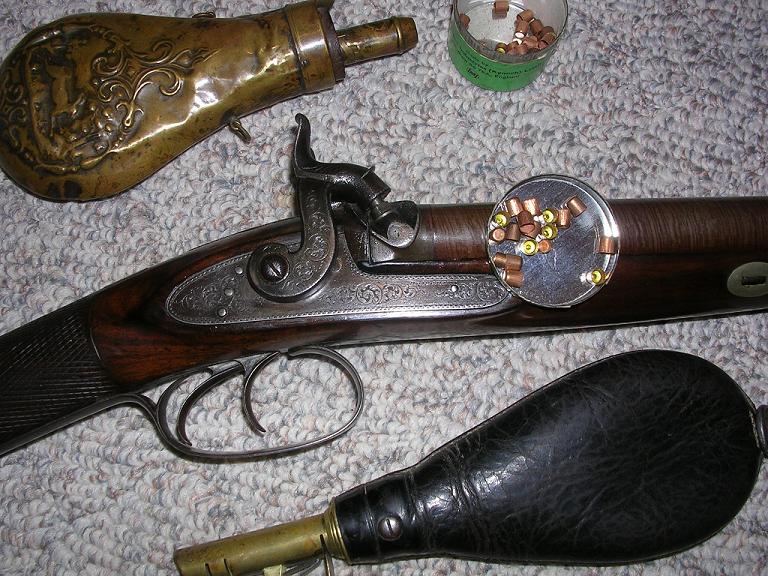
 Attachment: 116.38 KB
Attachment: 116.38 KB
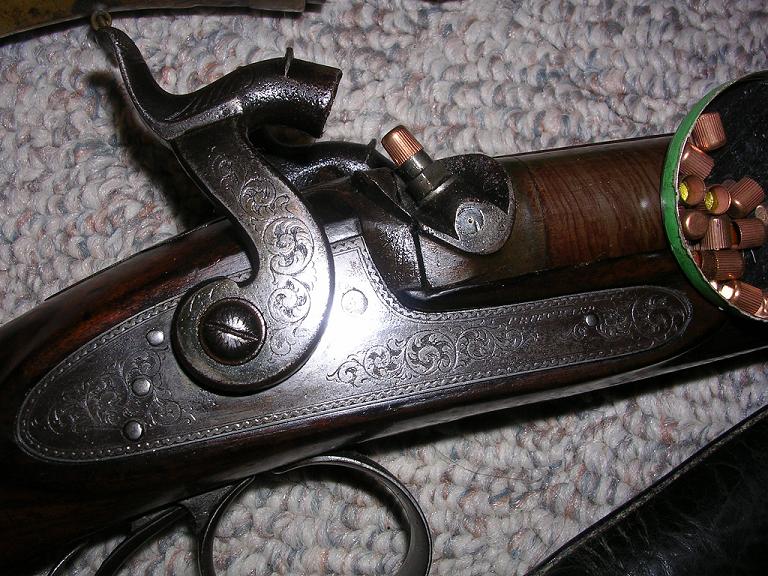
 Attachment: 124.95 KB
Attachment: 124.95 KB
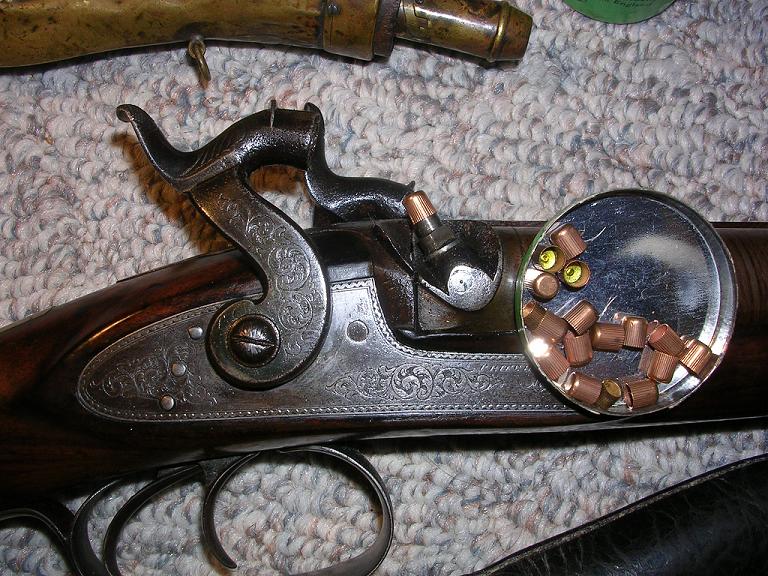
 Attachment: 123.9 KB
Attachment: 123.9 KB
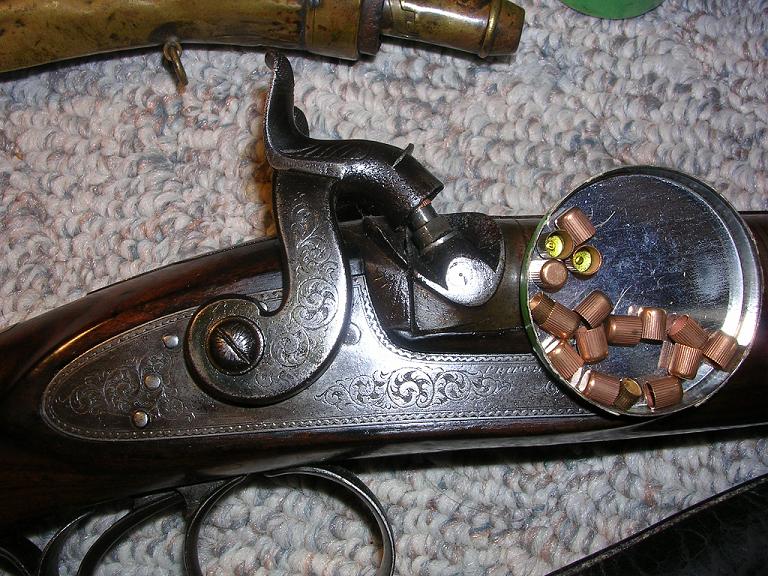
 Attachment: 93.96 KB
Attachment: 93.96 KB
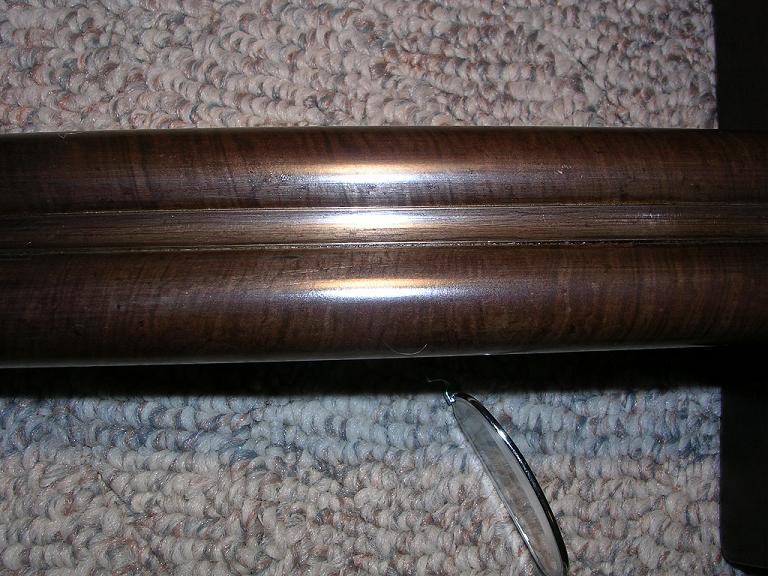





Thank you very much Richard for these excellent pictures. Do you also have pictures of flintlock and matchlock systems and weapons?
Kind regards
Manouchehr
Kind regards
Manouchehr
Manouchehr,
I have an original flintlock, and a few I made, plus one matchlock I made. If you wish, I could post some pictures of these, but if they're home-made, I do not know if this would be classed as advertising.
I will try and find out for you.
Best wishes,
Richard.
I have an original flintlock, and a few I made, plus one matchlock I made. If you wish, I could post some pictures of these, but if they're home-made, I do not know if this would be classed as advertising.
I will try and find out for you.
Best wishes,
Richard.
Manouchehr,
I have just checked again on the rules, and though I do not make things as a commercial venture, it would I believe be inappropriate to show pictures of home-made things on this site.
I will try and send a picture of the original flintlock in the next day or so.
Best wishes,
Richard.
I have just checked again on the rules, and though I do not make things as a commercial venture, it would I believe be inappropriate to show pictures of home-made things on this site.
I will try and send a picture of the original flintlock in the next day or so.
Best wishes,
Richard.
| Richard Hare wrote: |
| Manouchehr,
I have just checked again on the rules, and though I do not make things as a commercial venture, it would I believe be inappropriate to show pictures of home-made things on this site. I will try and send a picture of the original flintlock in the next day or so. Best wishes, Richard. |
I'm not a moderator but people show their personal projects often here: What can be delicate is offering them for sale as an ongoing business but showing something out of pride of workmanship or to give usefull information seems O.K. to me.
( Ask, a moderator or Nathan in a P.M. if you are not sure how to interpret the rules dealing with any issue. :D )
Thank you very much Richard for posting the flintlock here. That is really excellent that you have so much experience in antique firearms. Although I know it is really hard to say this in exact dates, could you please answer these questions:
a) When and where was the first matchlock introduced in Europe?
b) When and where was the first flintlock invented?
c) When and where was the first percussion system introduced?
I believe Europeans also used the wheellock system. Could you please shed some light on it and explain the system? Thank you very much. Regarding the other question, I would check with Nathan or other moderators. Thanks again Richard for your excellent and fascinating explanations. I really appreciate it.
Kind regards
Manouchehr
a) When and where was the first matchlock introduced in Europe?
b) When and where was the first flintlock invented?
c) When and where was the first percussion system introduced?
I believe Europeans also used the wheellock system. Could you please shed some light on it and explain the system? Thank you very much. Regarding the other question, I would check with Nathan or other moderators. Thanks again Richard for your excellent and fascinating explanations. I really appreciate it.
Kind regards
Manouchehr
Page 1 of 2
You cannot post new topics in this forumYou cannot reply to topics in this forum
You cannot edit your posts in this forum
You cannot delete your posts in this forum
You cannot vote in polls in this forum
You cannot attach files in this forum
You can download files in this forum
All contents © Copyright 2003-2006 myArmoury.com — All rights reserved
Discussion forums powered by phpBB © The phpBB Group
Switch to the Full-featured Version of the forum
Discussion forums powered by phpBB © The phpBB Group
Switch to the Full-featured Version of the forum